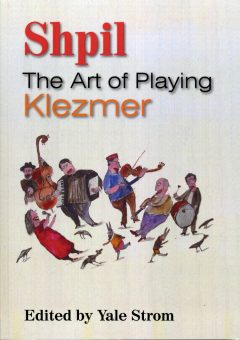Book Reviews
Shpil: The Art of Playing Klezmer

Edited by Yale Strom.
Providing both a history of klezmer, as well as being an instructional book, Shpil: The Art of Playing Klezmer is a primer for the appreciation and performance of this musical genre that is filled with life and joy.
Yale Strom is a world-renowned musician, ethnographer, composer, writer, and filmmaker. He is also currently an Artist in Residence at SDSU. In the early eighties, before the fall of the Berlin Wall and the breakup of the Soviet Union, Strom traveled to Eastern Europe to record and document the klezmer music of the Jews living in the Communist Bloc. More than 35 years after World War II, this population was still decimated and marginalized. With the upheavals of the eighties further eroding these communities and their traditions, much of their music was threatened with extinction.
Strom made a Herculean effort to document and record the music of Eastern European Jews, spending hours upon hours with fiddlers and other klezmer musicians to learn the songs, as well as the embellishments that characterize this music. Often lacking access to copying machines, he sometimes spent days copying by hand sheet music and texts of klezmer and other Jewish music. In addition to documenting and performing klezmer, Strom has also written several books on the lives and culture of Eastern European Jews.
Shpil is Strom’s latest book on klezmer. In less than 30 pages of the book’s opening, he gives an almost breathless history of Jewish music, from its earliest mentions in the Bible through the 1990s. The tour includes the fall of the Temple in the first century, the empires of the Ottomans, Russia, and Austro-Hungary, U.S. labor and immigration history, the development of the Borscht Belt in New York’s Catskills, World War II, and the Nazi Holocaust through the recordings and performances of Mickey Katz and Don Byron. Carlos Santana even gets a mention.
In subsequent chapters, musicians who have worked with Strom and his klezmer band, Hot Pstrami, offer their insights into playing the instruments found in a small klezmer ensemble. Prominent San Diego bassist Jeff Pekarek gives an introduction to the role of string bass in klezmer; Strom’s wife, Elizabeth Schwartz, explains the art of singing klezmer. Norbert Stachel wrote the chapter on the clarinet. Peter Stan contributes a chapter on the accordion, and drumming in a klezmer band is explained by Klezmatics cofounder David Licht. Strom wrote the chapter on klezmer violin.
Besides explaining such things as tone development and playing the embellishments that make klezmer so distinctive and enjoyable, each of the chapters’ authors also provide historical and cultural contexts in which their instruments developed within klezmer. Those serious about studying and performing this genre would do well to check out the reference notes and recommended readings, as well as the recordings suggested in the discographies, that accompany each chapter.
In its 153 pages Shpil could not possibly contain all that one might want to know about klezmer or its performance. But with its densely packed chapters, it provides a perfect place to start in understanding and playing this most joyous and wonderful music.
Yale Strom, Elizabeth Schwartz, and Jeff Pekarek will be at Mission Hills Books & Collectibles on thursday, April 11, for a concert and book signing at 7pm. The store is located at 4054 Goldfinch Street in Mission Hills.






